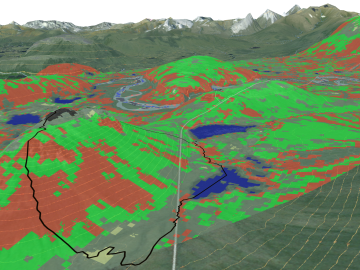
Filter News
Area of Research
- (-) Energy Science (56)
- (-) Neutron Science (41)
- (-) Nuclear Science and Technology (15)
- Advanced Manufacturing (6)
- Biological Systems (1)
- Biology and Environment (38)
- Building Technologies (1)
- Computational Biology (2)
- Computational Engineering (3)
- Computer Science (16)
- Electricity and Smart Grid (1)
- Functional Materials for Energy (1)
- Fusion and Fission (27)
- Fusion Energy (15)
- Isotope Development and Production (1)
- Isotopes (8)
- Materials (97)
- Materials Characterization (1)
- Materials for Computing (18)
- Materials Under Extremes (1)
- Mathematics (1)
- National Security (26)
- Quantum information Science (6)
- Sensors and Controls (1)
- Supercomputing (122)
- Transportation Systems (1)
News Topics
- (-) Biomedical (22)
- (-) Computer Science (37)
- (-) Exascale Computing (2)
- (-) Fusion (10)
- (-) Materials Science (51)
- (-) Security (8)
- 3-D Printing/Advanced Manufacturing (86)
- Advanced Reactors (15)
- Artificial Intelligence (14)
- Big Data (7)
- Bioenergy (31)
- Biology (18)
- Biotechnology (5)
- Buildings (38)
- Chemical Sciences (17)
- Clean Water (10)
- Composites (18)
- Coronavirus (23)
- Critical Materials (9)
- Cybersecurity (10)
- Energy Storage (74)
- Environment (59)
- Fossil Energy (3)
- Frontier (3)
- Grid (39)
- High-Performance Computing (8)
- Hydropower (3)
- Isotopes (6)
- Machine Learning (10)
- Materials (46)
- Mathematics (3)
- Mercury (3)
- Microelectronics (1)
- Microscopy (10)
- Molten Salt (5)
- Nanotechnology (17)
- National Security (7)
- Neutron Science (123)
- Nuclear Energy (42)
- Partnerships (12)
- Physics (11)
- Polymers (12)
- Quantum Computing (1)
- Quantum Science (8)
- Simulation (4)
- Space Exploration (10)
- Statistics (1)
- Summit (9)
- Transportation (68)
Media Contacts

Ionic conduction involves the movement of ions from one location to another inside a material. The ions travel through point defects, which are irregularities in the otherwise consistent arrangement of atoms known as the crystal lattice. This sometimes sluggish process can limit the performance and efficiency of fuel cells, batteries, and other energy storage technologies.

Scientists at Oak Ridge National Laboratory have developed a low-cost, printed, flexible sensor that can wrap around power cables to precisely monitor electrical loads from household appliances to support grid operations.

OAK RIDGE, Tenn., March 20, 2019—Direct observations of the structure and catalytic mechanism of a prototypical kinase enzyme—protein kinase A or PKA—will provide researchers and drug developers with significantly enhanced abilities to understand and treat fatal diseases and neurological disorders such as cancer, diabetes, and cystic fibrosis.


Oak Ridge National Laboratory scientists have created open source software that scales up analysis of motor designs to run on the fastest computers available, including those accessible to outside users at the Oak Ridge Leadership Computing Facility.

A team of scientists led by Oak Ridge National Laboratory used machine learning methods to generate a high-resolution map of vegetation growing in the remote reaches of the Alaskan tundra.
![Coexpression_hi-res_image[1].jpg Coexpression_hi-res_image[1].jpg](/sites/default/files/styles/list_page_thumbnail/public/Coexpression_hi-res_image%5B1%5D_0.jpg?itok=ww635BCP)
While studying the genes in poplar trees that control callus formation, scientists at Oak Ridge National Laboratory have uncovered genetic networks at the root of tumor formation in several human cancers.

The Department of Energy’s Oak Ridge National Laboratory is collaborating with industry on six new projects focused on advancing commercial nuclear energy technologies that offer potential improvements to current nuclear reactors and move new reactor designs closer to deployment.

To learn more about interactions between drug molecules and micelles, Associate Professor Megan Robertson and graduate students Tyler Cooksey and Tzu-Han Li from the University of Houston (UH) are using neutrons at the Department of Energy’s (DOE’s) Oak Ridge National Laboratory (ORNL).
![2018-P07635 BL-6 user - Univ of Guelph-6004R_sm[2].jpg 2018-P07635 BL-6 user - Univ of Guelph-6004R_sm[2].jpg](/sites/default/files/styles/list_page_thumbnail/public/2018-P07635%20BL-6%20user%20-%20Univ%20of%20Guelph-6004R_sm%5B2%5D.jpg?itok=hUSyvkP0)
A team of scientists, led by University of Guelph professor John Dutcher, are using neutrons at ORNL’s Spallation Neutron Source to unlock the secrets of natural nanoparticles that could be used to improve medicines.


